AI Art vs Human Art
Imagine stepping into a world where art is made by people using their imagination and another world where computers create art with artificial intelligence. We're about to dive into these two cool worlds: one where PSDDude makes mind-blowing art with Photoshop tricks, and another where AI generates art that's totally mind-boggling. Let's take a look at both and see how they're similar and different. Ready? Let's go!
Let The Battle Begin: AI Art vs Human Art
It's not really a battle, but I'm curious to hear what you guys think about this. I've decided to take some of my old works of Photoshop photo manipulations and try to re-create them using AI.
For the AI generated art there's been quite an explosion in available tools. AI models have been trained on huge sets of images and are able to produce amazingly realistic and artistic results.
Let's see which tools we use for this.
Which AI Image Generator From Text Is Best?
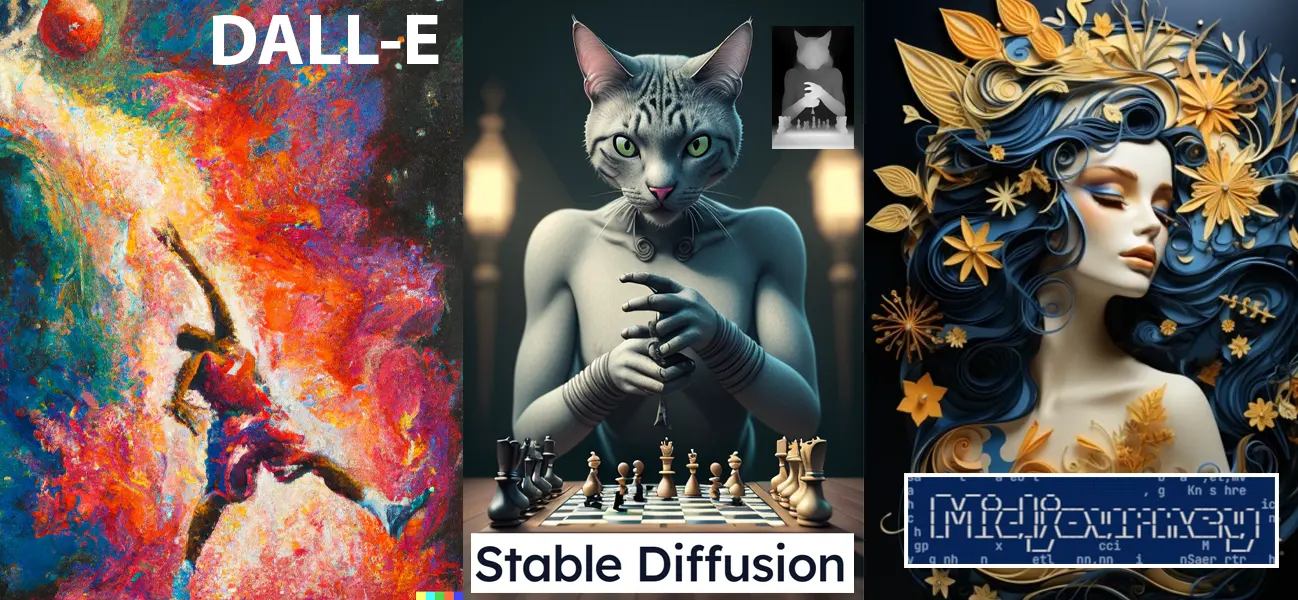
Here are the most well known image AI generators
For AI image generation from text you have a lot of options out there, but my absolute favorites are:
- Automatic1111 - also called Stable Diffusion Web UI, it's actually a free and opensource web interface built on top of StableDiffusion models. You can install it on your computer, but you need a relatively good graphics card and a bit of knowledge to install.
- MockoFun - an online graphic design application that has AI tools like the AI image generator from text, image to image and image transformation AI tools. I like this becaue it's so easy to use and it also has a lot of other features that resemble Photoshop, so I feel more comfortable working with it.
DALL-E 3 and the latest Midjourney v6 features are awesome tools, but they cost quite a lot.
For me, I think that Automatic1111 and MockoFun are the best AI image generators. So, I will use them for generating images from text and also modifying the images that will go into the comparison.
Let's begin!
AI Art vs Human Art - ROUND #1 The Frozen Queen
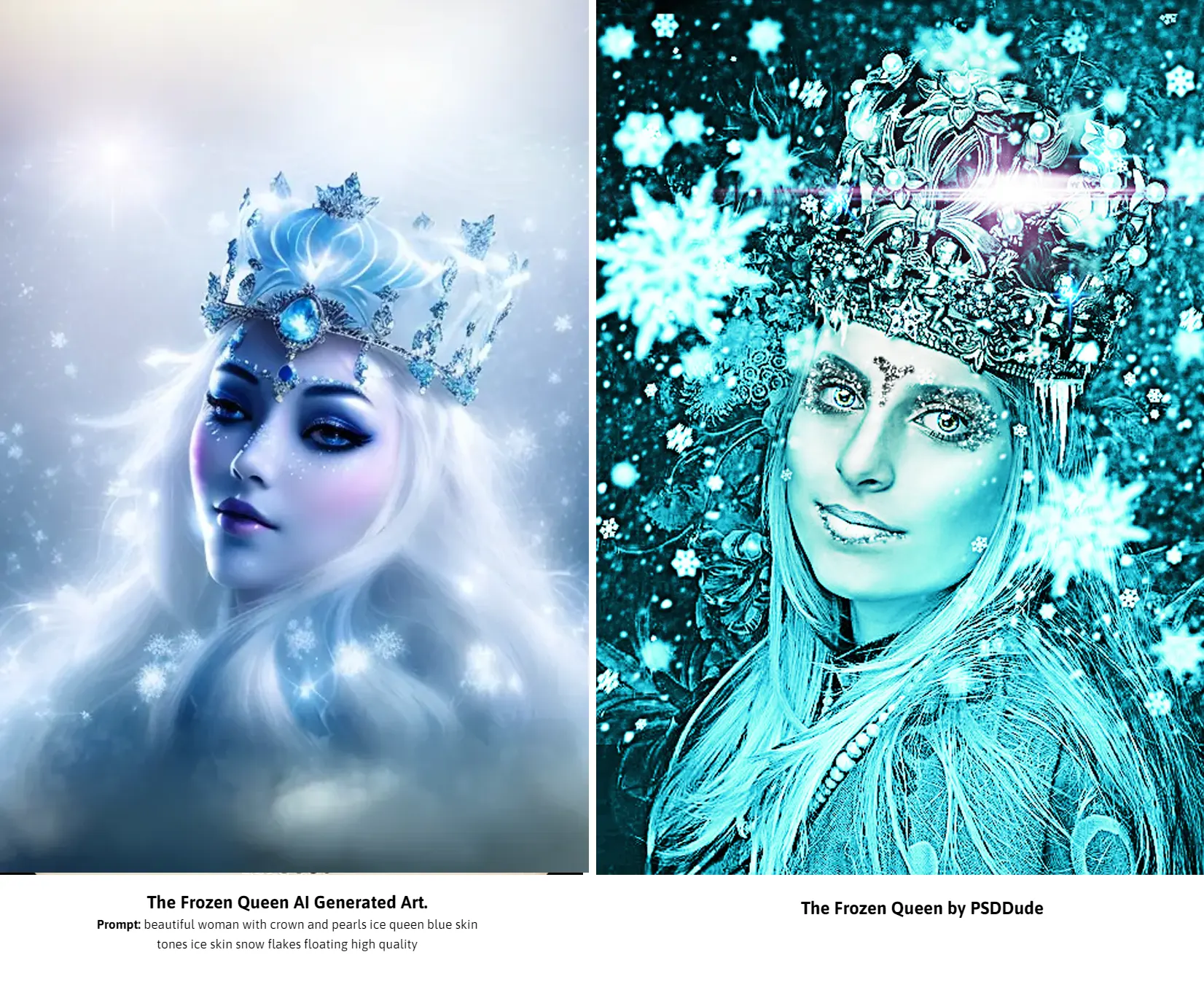
AI Art vs Human Art - ROUND #2 Vintage Photo Effect
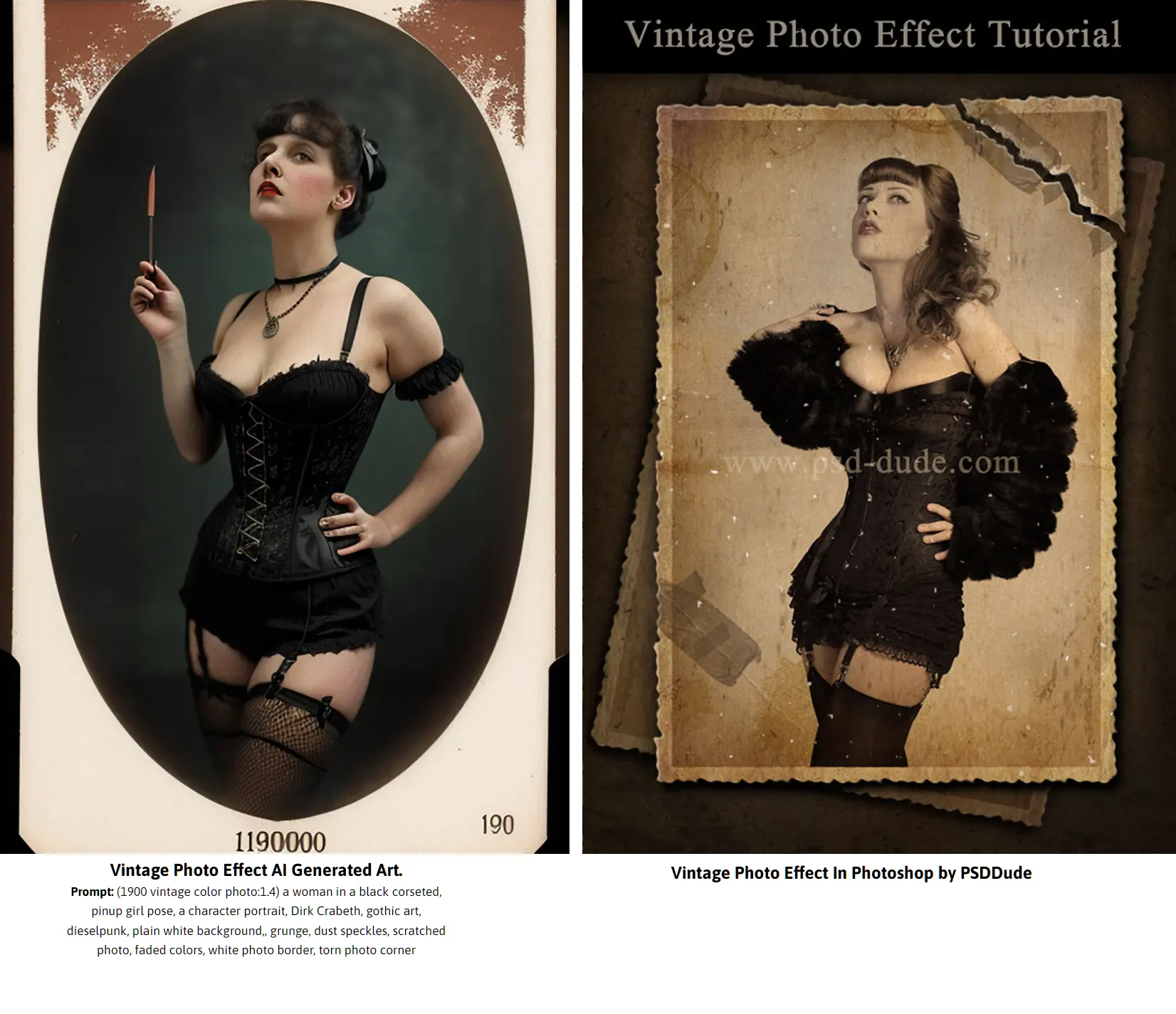
AI Art vs Human Art - ROUND #3 Christmas Fantasy Tale
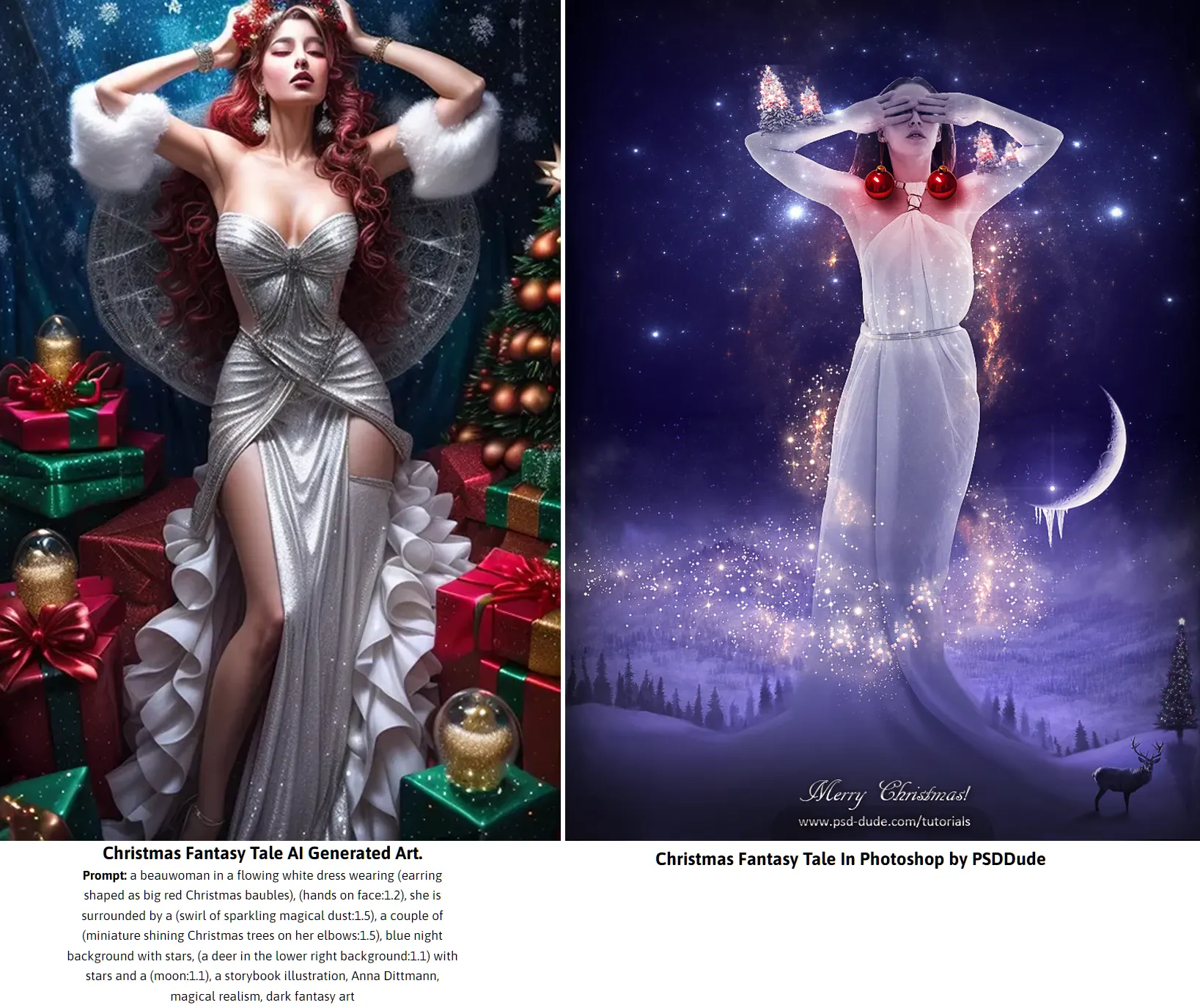
AI Art vs Human Art - ROUND #4 Alice In Wonderland: Mad Hatter
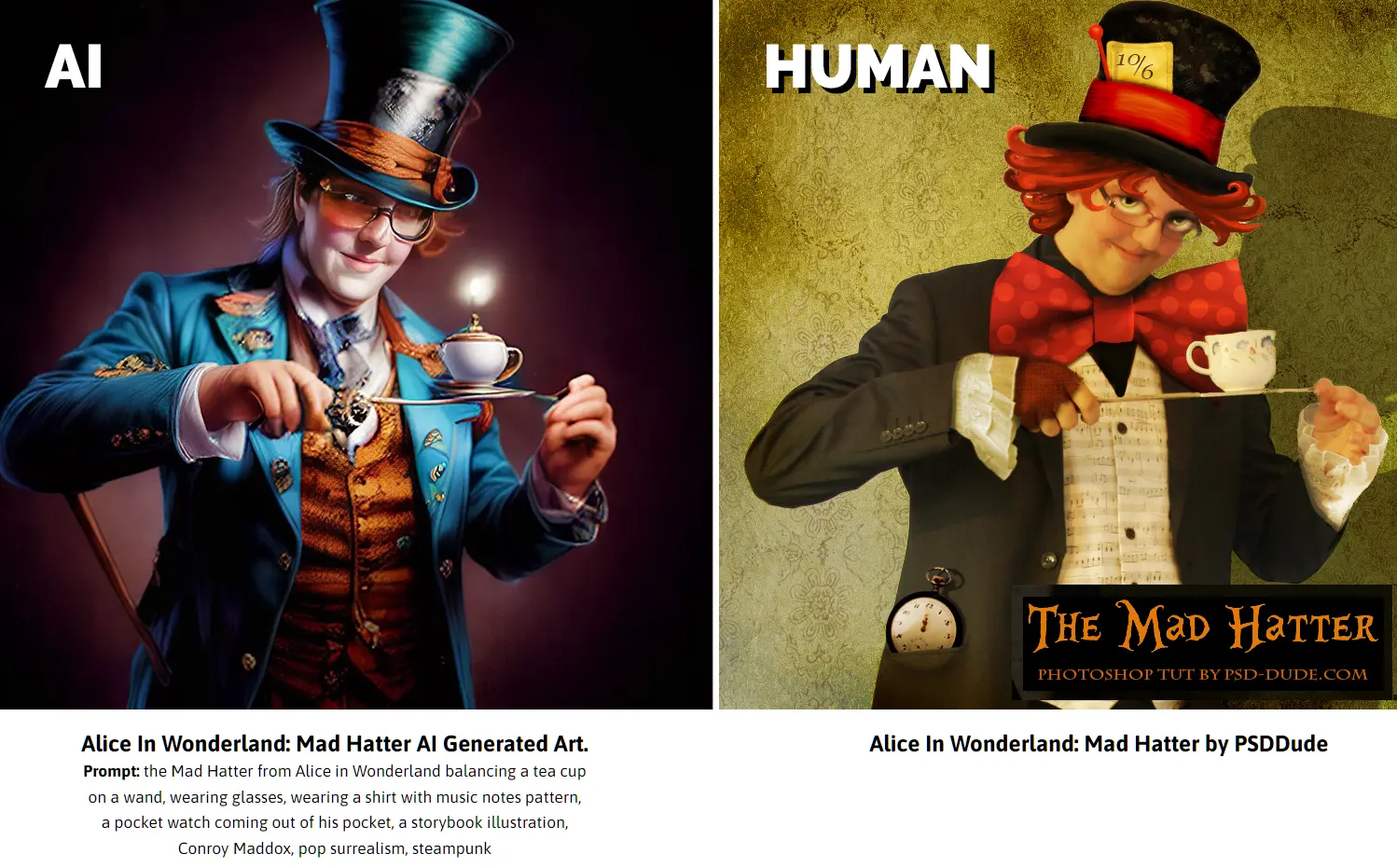
AI Art vs Human Art - ROUND #5 Childhood End The Last Days On Earth
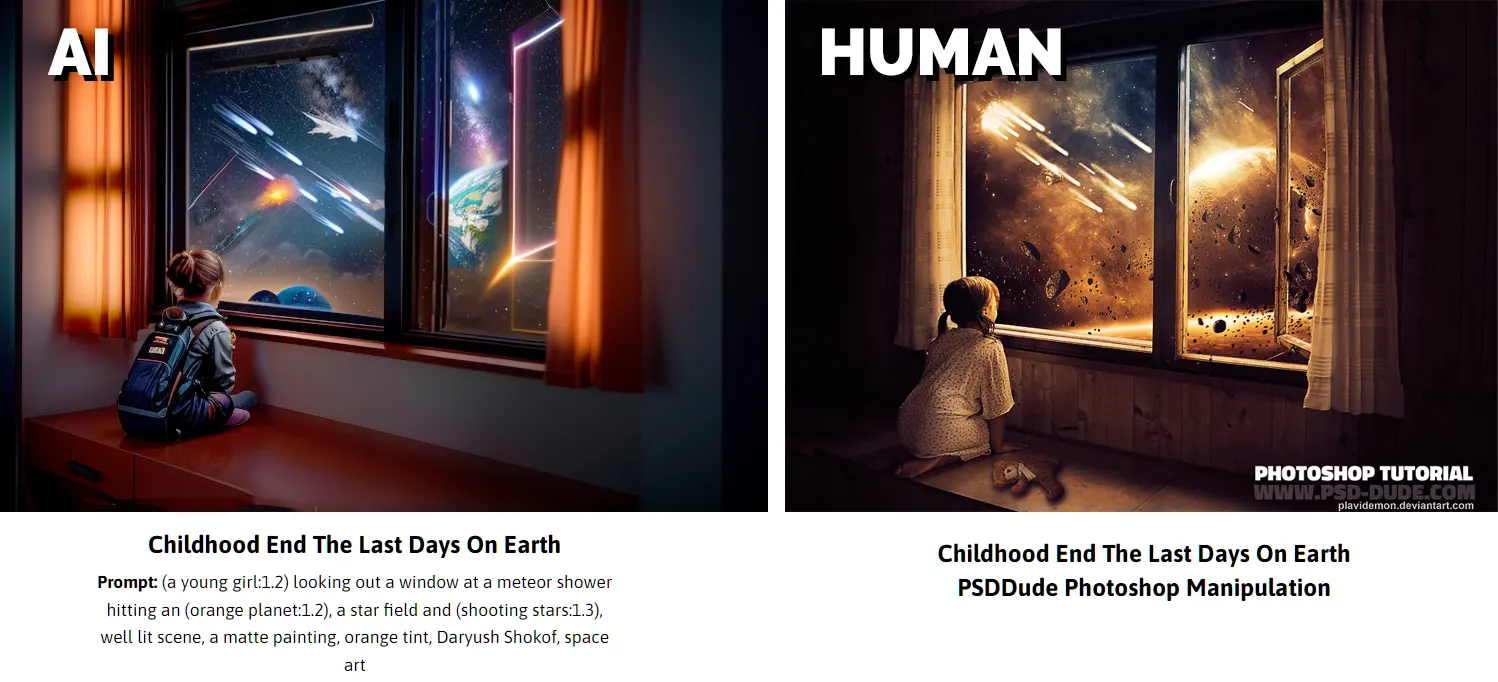
AI Generated Art: The Workflow
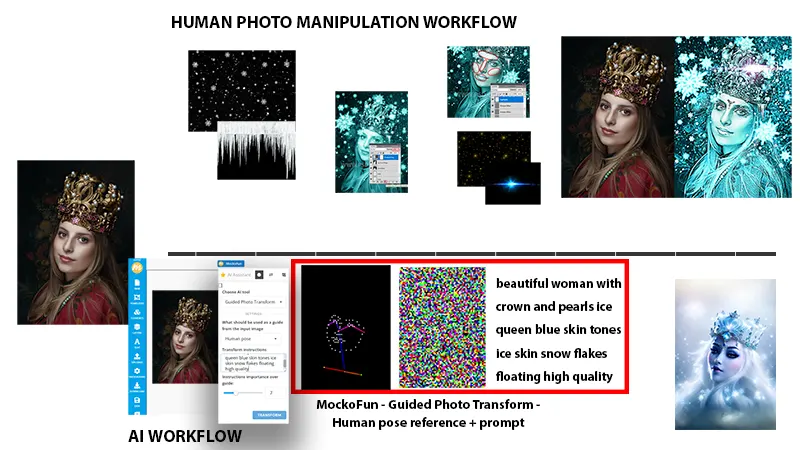
Here you can see the workflow for creating the photo manipulation in Photoshop in the Frozen Queen tutorial. As for the AI process, I've used MockoFun's Guided Photo Transform on the original photo.
Also, I had to come up with prompts, that is a description which serves as instruction for the AI generator.
Guided Photo Transform in MockoFun or in other tools named ControlNet works by using an image as reference for either of these options:
- Shapes, depth and perspective - mainly used to copy the composition of an image, or the perspective. Great for architecture but also other things
- Human pose - this tool mimics the pose or posture from the source image when generating a new image. Internally this uses something called OpenPose which is basically a format for representing the position of the face, arms and legs.
- Exact edged and contours - extracts and copies edges from the source image. This is great if you need to extract facial features or details from an image.This method is also called canny edge detection.
- Line art edges and contours - uses the lines and contours in the source image to generate a new image. Similar to canny edge detection, but does not take small details into consideration
- Doodle strokes - this method is used for transforming doodle drawings to images. This is an awesome tool to use in MockoFun, especially because the MockoFun has an awesome Doodler tool that allows doodle drawing.
I've used similar workflows in either MockoFun or Automatic1111 to produce the AI generated art in this article with only slight variations. What you have to know is that when generating AI art you have to go through a trial and error process. The key here is to find a method through which your results are improving with every new generated image.
I've devised a crude scoring system 0 to 5 stars. By the way, I'm using simple text star symbols. You can copy/paste more such star symbols from one of my old posts. For each side-by-side comparison between AI art and human art we'll look at:
| AI Generated Art | Human Art | |
|---|---|---|
| Idea & Composition | 2.0 ★★✰✰✰Since the idea was mine in the first place, I would say that the AI had only a limited contribution here. As for the composition, I used the guided smart photo edit, which basically extracted hints for the composition from an input image. | 5.0 ★★★★★My idea, my composition, so I'll give myself maximum score here |
| Execution Time | 5.0 ★★★★★ - between 3-5 mins There's no question about this. AI image generation is many-many times faster than bany kind of human graphic designer. | 3.0 ★★★✰✰ - aprox 2h 30mins Making photo manipulations takes a lot of time. It involves a lot of steps for doing and re-doing. I didn't even include here the amount of time it took me to find the right stock images. |
| Emotional Resonance | 3.5 ★★★✰✰I must say, that the results are pretty impressive, and it's really hard to tell the difference between a work made with AI and one made by a human when it comes to emotional resonance. However, there were slight problems on some generations with weird hand shapes or the eyes. | 4.5 ★★★★✰I would give myself the max score, but, I have to admit that even though I'm choosing the starting stock images myself, and I'm modifying them according to my artistic feeling, stock images/models are kind of a limitation. |
| Surprise Factor | 5.0 ★★★★★AI-generated images offer an unpredictable twist. It introduces an element of surprise that often diverges from traditional artistic expectations. Just think how many times you said to yourself "I can't believe how good this generated AI image is" | 4.0 ★★★★✰While you anticipate the outcome, a degree of control is exercised. Yet, sometimes, the creative process introduces its own surprises. |
| Future Explorations | 5.0 ★★★★★AI's journey is one of learning and growth, adapting to the nuances it encounters. Its future holds the promise of intricate evolution, all shaped by the data it consumes. AI generators have gotten better and better at an ever faster rate. | 4.0 ★★★★✰I like to believe that with every new photo manipulation I create I'm learning more and more things. I also like to believe that my style is improving with time. However, my improvement rate is not as fast as the evolution AI image generation technologies. |
| AVERAGE SCORES | 4.1 ★★★★✰ | 4.1 ★★★★✰ |
Hmmm, it's a tie!
What do you think?
AI Art vs Real Art
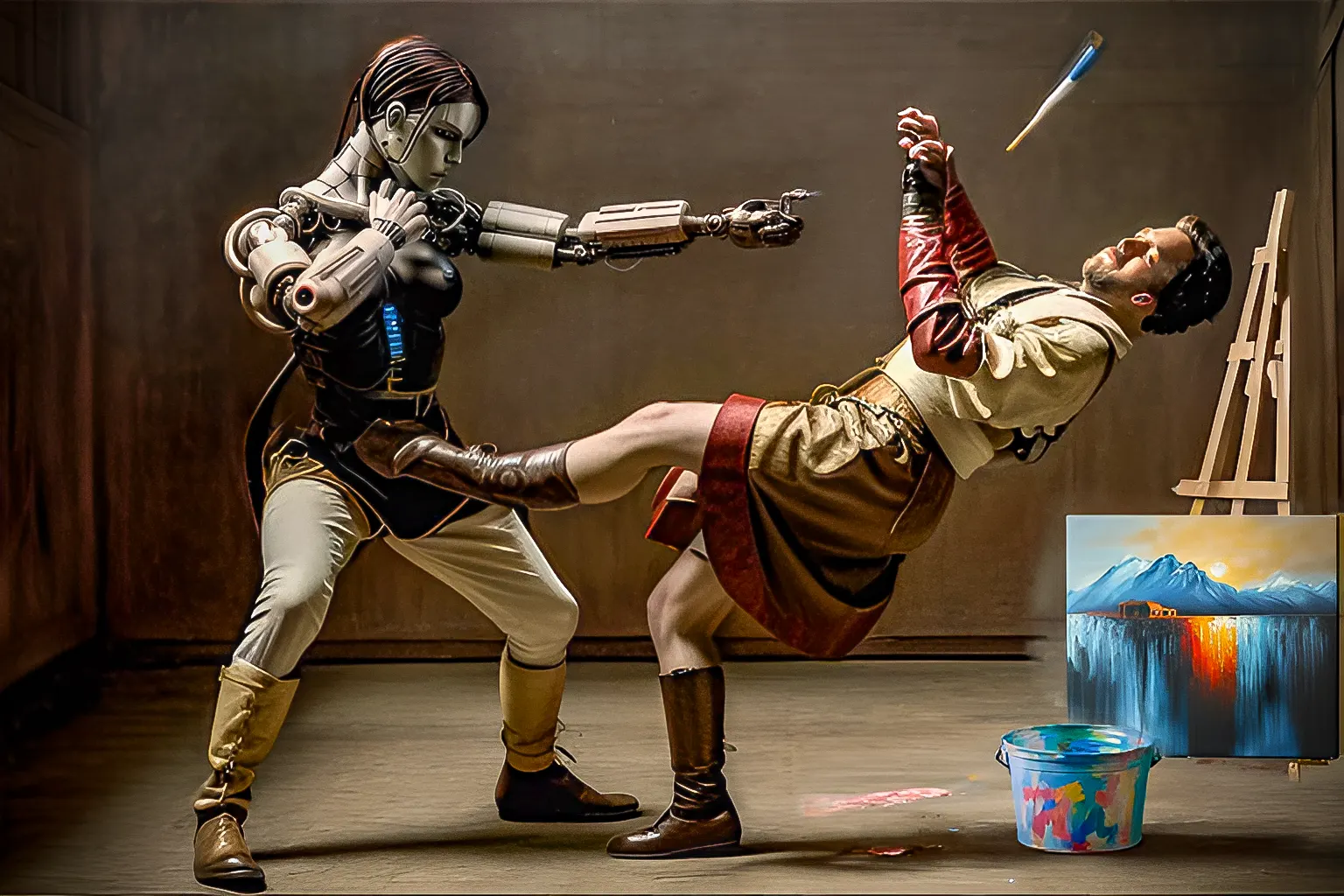
Artificial intelligence (AI) is rapidly changing the world, and the art world is no exception. AI-generated art is becoming increasingly sophisticated, and some people believe that it is indistinguishable from art created by humans.
AI art vs real art is a hotly debated topic. Some people believe that AI art is not truly art, while others believe that it can be just as creative and meaningful as art created by humans.
There are a number of key differences between AI art and human art. AI art is typically created by feeding a computer program with a large dataset of images or artworks. The program then uses this data to generate new images that are similar to the ones it has seen. This process can be very efficient, and AI-generated art can be produced quickly and in large quantities.
However, AI art often lacks the emotional and personal touch that human-made art has. This is because AI programs are not capable of understanding the same things as humans do, and they cannot express their own emotions in their work.
A recent AI art vs human art test found that people were often unable to tell the difference between AI art and art created by humans. This suggests that AI art is becoming increasingly sophisticated and may soon be indistinguishable from real art.
Ultimately, whether or not AI art is considered to be "real art" is a matter of opinion. Some people believe that AI art is simply a tool that can be used to create art, while others believe that it is a new form of art that is capable of standing on its own.
Pros And Cons Of AI Art
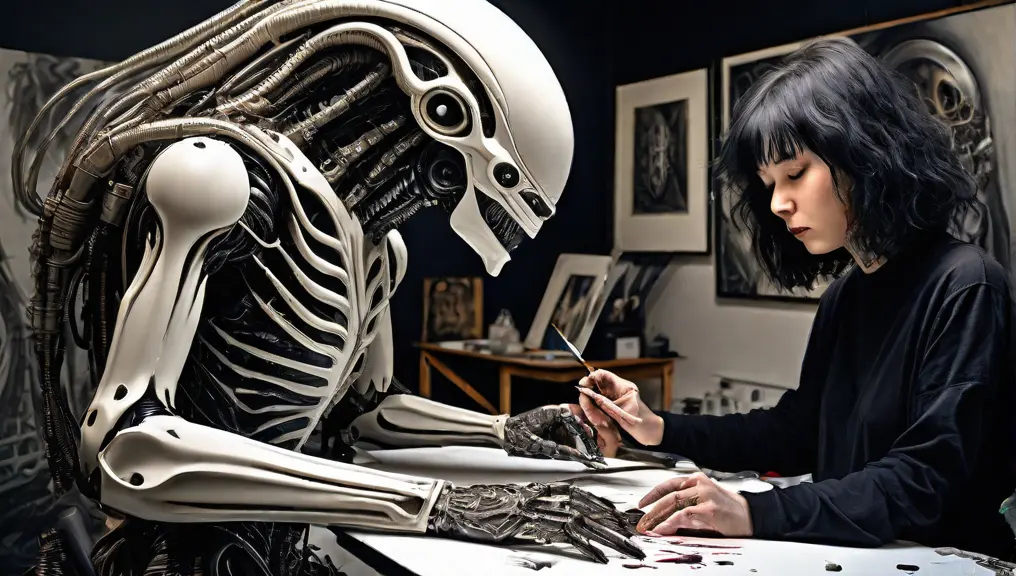
PROS:
- Creativity and innovation: AI art can be more creative and innovative than human art, as it is not limited by the same constraints. AI can generate new ideas and concepts that would not have been possible for humans to come up with on their own.
- Speed and efficiency: AI art can be created much faster than human art, as it can process vast amounts of data in a fraction of the time. This makes it a valuable tool for artists who need to create art quickly or who need to create a large number of artworks.
- Accessibility: AI art is more accessible than human art, as it can be created and shared online. This makes it possible for anyone to create and appreciate AI art, regardless of their artistic skills or resources.
- Potential for new forms of art: AI art has the potential to create new forms of art that would not have been possible without the use of AI. This could lead to a more diverse and expressive art world.
CONS:
- Lack of emotion and originality: AI art can sometimes lack the emotion and originality that human art has. This is because AI is not capable of understanding or expressing emotions in the same way that humans do.
- Questions of authorship and ownership: There are still questions about who should be credited as the author of AI art. Some people argue that the artist who created the algorithm should be credited, while others argue that the machine itself should be considered the author.
- Potential for bias: AI algorithms are only as good as the data they are trained on. If the data is biased, the AI art may also be biased. This could lead to the creation of art that is offensive or harmful.
- Potential for misuse: AI art could be used for malicious purposes, such as creating fake news or propaganda. It is important to be aware of the potential risks of AI art and to use it responsibly.
Overall, AI art has both potential benefits and risks. It is important to carefully consider these factors before using or creating AI art.
Is AI Art Better Than Humans?
The age-old debate: Can AI art outshine human creativity? While AI-generated art can produce astonishing pieces, it's not about being "better." AI brings a different flavor to the artistic table, often blending styles and techniques that human artists might not think of. You shouldn't think about this as AI art vs artists, as it's more like a duet than a competition.
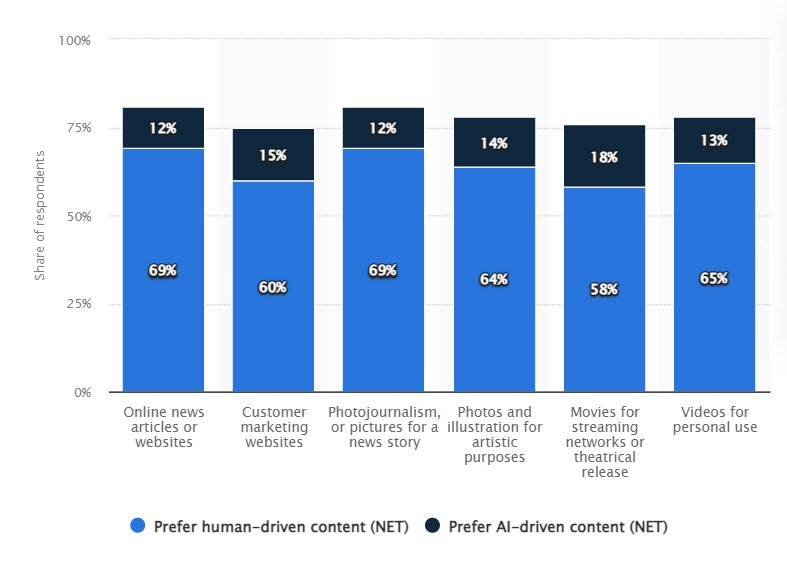
According to a recent study, people tend to prefer human-created art over AI-created art, regardless of the physical properties of the art. Multiple studies found that people rated artworks more positively when they were labelled as "Human-created" than when they were labelled as "AI-created", even though the artworks were actually created by AI. The study also suggests some possible reasons for this preference, such as the value of human engagement, emotion, and effort in the artistic process, and the personal attitudes toward AI.
In the statistical data used for the study, it seems that almost 70% of the respondents prefer human driven content when it comes to news and photojournalism. I've recently written an article about AI photojournalism and ethics in which this topic is covered in more detail.
Can AI Art Replace Human Art?
Short answer: No way! AI art might be a fantastic collaborator, but it can't replace the human touch. Art is more than just brushstrokes or pixels; it's about emotions, stories, and perspectives. AI lacks personal experiences and feelings, which are the heart and soul of many human-made masterpieces.
It is unlikely that AI art will be able to fully replace human art. While AI art has shown impressive capabilities in generating paintings, there are significant limitations to the current AI art process. These limitations include:
- the inability of AI to prioritize objects and emphasize certain elements
- the lack of meaningful order and layers in AI-generated art
- the incomplete artistic process in AI art
Human artists can think, understand what things mean, and purposefully connect ideas with how things look in their art. Machines that make art, like computers, can't do this as well. Also, artists who are people can learn and make their art different over time, but computer-made art doesn't really change its style much. So, even though computer art can be cool and helpful, it probably won't take the place of art made by people.
Do People Consider AI Art Real Art?
If it wasn’t created by a human artist, is it still art?
Absolutely! While some traditionalists might raise an eyebrow, the art world is embracing AI creations. Just like any form of art, AI-generated pieces evoke reactions and thoughts. Whether a computer or a human made it, if it sparks emotions and makes you ponder, it's art.
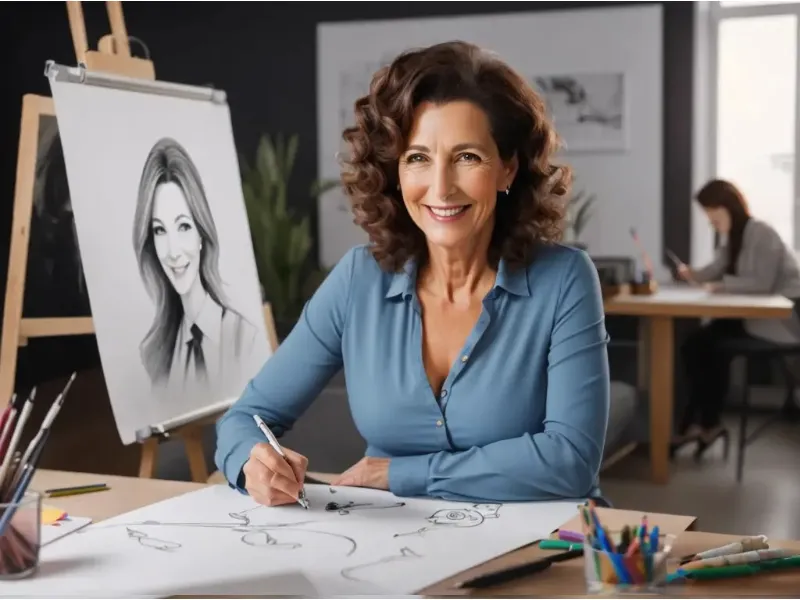
Some people consider AI-generated art to be a form of creativity and appreciate the unique aesthetic it offers. They view it as a new medium that expands the boundaries of traditional art. However, there are also those who argue that AI art lacks the human touch and emotional depth that is often associated with traditional art. They believe that true art requires the intention, skill, and personal expression of a human artist. Ultimately, whether AI art is considered "real art" is subjective and depends on individual perspectives and beliefs.
Is AI Art Good or Bad for Artists?
It's a mix of both. On one hand, AI tools like MockoFun open up new avenues for artists to experiment and collaborate. They can enhance their creative process, helping them visualize ideas in fresh ways. On the flip side, some worry that heavy reliance on AI might lead to a loss of traditional skills. The key is balance; using AI as a tool, not a crutch.
The potential effects of AI art on artists can be both positive and negative. On the positive side, AI art can provide inspiration to artists by generating diverse and random images, helping them explore new perspectives and break away from familiar styles. It can also reduce artists' workload by automating tedious and redundant tasks, allowing them to focus on more creative aspects. Additionally, AI art can increase the accessibility of art creation, enabling individuals without professional training to bring their creative ideas to life.
However, there are also negative aspects to consider. One concern is the incomplete artistic process in AI art. While users may claim to provide artistic ingenuity through content prompts and selection, artists may view this as a limitation. They believe that the artistic process involves a deliberate association between content and aesthetic features, which is lacking in AI-generated art. Another issue is the potential impact on the livelihood of artists. With the ability to produce high-quality paintings at a low cost, AI art may lead to job loss and a decrease in demand for human artists.
Overall, the effects of AI art on artists are complex and multifaceted, with both benefits and challenges. It is important to consider the perspectives of artists and find ways to integrate AI technology in a manner that promotes shared prosperity and collaboration between human artists and AI systems.
You can read more about differences between AI art and human art and other considerations and implications of developments in AI generated art in this scientific paper called "Everyone Can Be Picasso? A Computational Framework into the Myth of Human versus AI Painting".
Short History of AI Generated Images
We're about to take a wild ride into the world of art and technology. You know how art has been this amazing way for people to express themselves over time? Well, hold on tight, because the era of AI, or Artificial Intelligence, is shaking things up and giving art a futuristic twist. Get ready to explore how AI is revolutionizing the art scene and making creativity even more mind-blowing!
1. The Early Days of Pixel Art (1950s - 1990s)
Back in the day, computers were just learning to walk. The concept of AI-generated art was a bit far-fetched. People were still trying to figure out how to make computers understand the basics of images. Think of this time as the "pixel art" era, where computers could create simple designs using tiny squares of color called pixels.
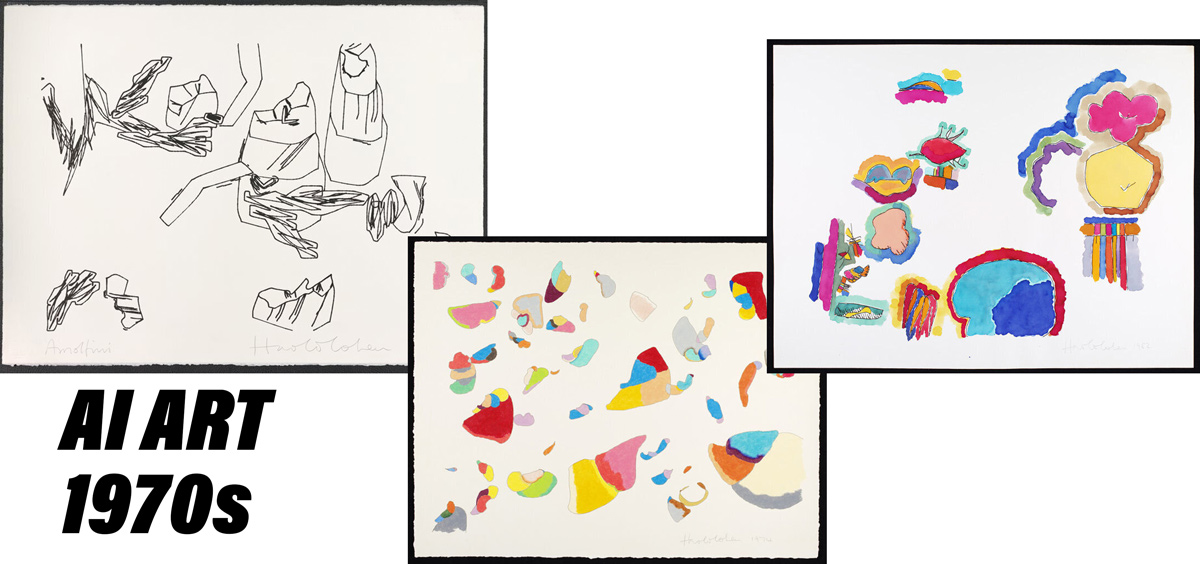
Harold Cohen was a British-born artist who was noted as the creator of AARON, a computer program designed to produce paintings and drawings autonomously. His work in the intersection of computer artificial intelligence and painting lead to exhibitions at many museums, including the Tate Gallery in London
2. The Rise of Neural Networks (2000s)
As computers got smarter, neural networks entered the scene. These networks are like supercharged brains that can learn and recognize patterns. Artists and scientists started training these networks to create art. It was like teaching a computer to paint, and the results were mind-boggling. AI could now generate images that looked like they were made by human hands.
3. Deep Learning Takes the Stage (2010s)
Hello, deep learning! This is when AI gets a mega upgrade. Deep learning is like giving AI a super telescope to see even the tiniest details in images. Computers started creating stunning pieces of art that could mimic different styles. Want a painting that looks like Van Gogh's? No problem. How about a photo that seems straight out of a fantasy movie? Done!
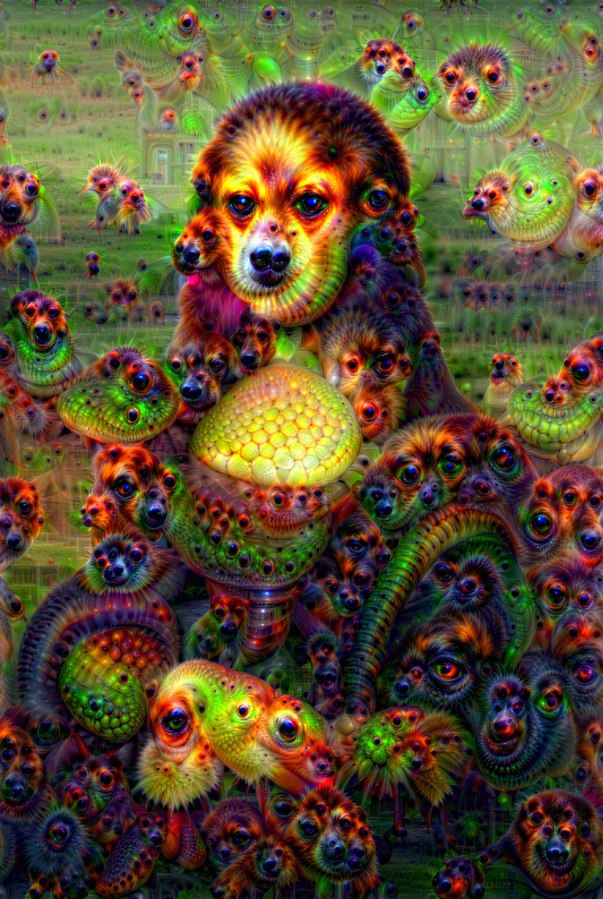
DeepDream is a computer vision program created by Google engineer Alexander Mordvintsev that uses a convolutional neural network to find and enhance patterns in images via algorithmic pareidolia, thus creating a dream-like appearance reminiscent of a psychedelic experience in the deliberately overprocessed images. It was released in 2015.
4. Today's AI Art Revolution (2020s - Present)
Welcome to the AI art revolution! Computers are now not just creating art; they're collaborating with artists to blow our minds. Tools like MockoFun are making it easier than ever for artists and everyday folks to dip their toes into the AI art world. With a few clicks, you can turn a regular photo into something extraordinary. AI is like a genie granting artistic wishes.
In Conclusion
There are both similarities and differences between the two forms of art. AI-generated art can be more efficient and faster to create, while human art allows for a personal touch and emotional depth that AI art may lack. AI art has the potential for creativity and innovation, but it may also lack originality and the ability to express emotions in the same way as human art. Overall, AI art and human art offer unique perspectives and can coexist as different forms of artistic expression.
Online video photo editor
Photoshop Text Effect Tutorials Perfect for Valentine Day

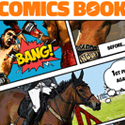
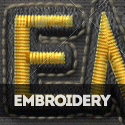
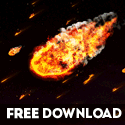
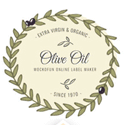

No comment(s) for "AI Art vs Human Art"